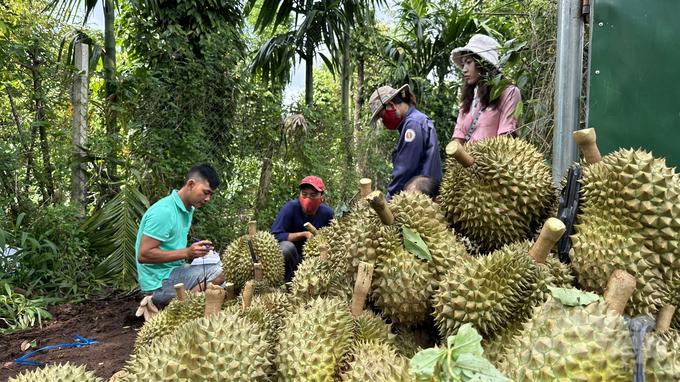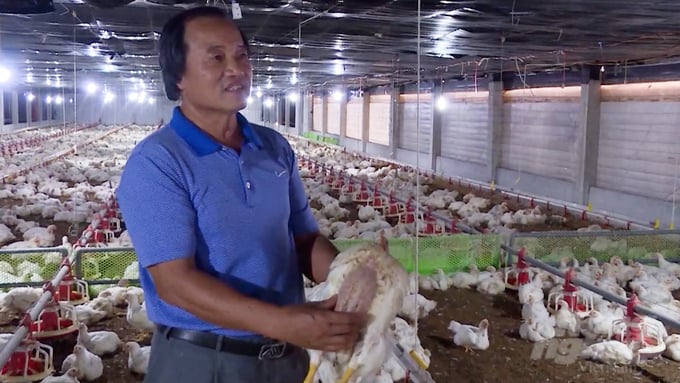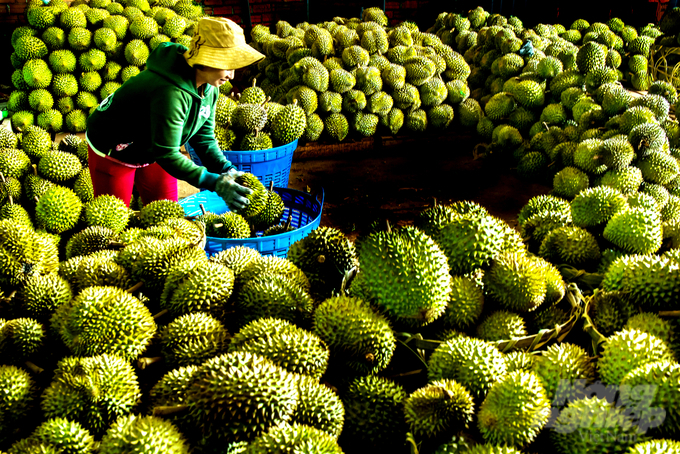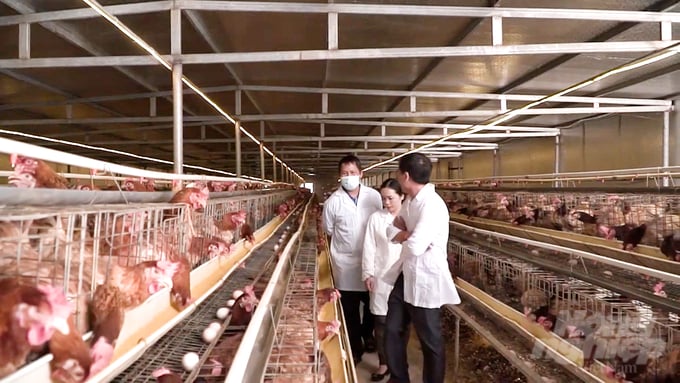May 20, 2025 | 15:14 GMT +7
May 20, 2025 | 15:14 GMT +7
Hotline: 0913.378.918
May 20, 2025 | 15:14 GMT +7
Hotline: 0913.378.918
During the recent durian harvest season, over 1,000 hectares of durian farms owned by the Agricultural Service Cooperative in Ward 7, Thanh Son Commune, Dinh Quan district, Dong Nai province are no longer subject to price fluctuations with the help of production linkages with businesses. Accordingly, the cooperative guided its members to produce in compliance with the standards provided by the business. As a result, the cooperative's durian products were guaranteed to be sold at prices higher than the market rate.
Mr. Vo Van Tung, the Director of the Cooperative, stated that they had formed a partnership with Thuan Huong Company, which provided them with a designated cultivation area code and ensured stable product distribution. This was made possible because the durian produced by the cooperative had been exported to China.

Several production linkage models between cooperatives and businesses have been established in Dong Nai province. Photo: MS.
According to Mr. Tung, his cooperative successfully developed an 85-hectare durian farm during the initial stages of establishing a production linkage with businesses. The farm, which primarily encompasses durian trees ranging from their fourth to eighth year of growth, is currently in the harvesting season and has been assigned production unit codes. On the other hand, approximately 1,000 hectares of durian in Thanh Son commune are not given a production unit code. These farms predominantly consist of trees in their second to third year of growth. As a result, the cooperative plans to reinforce its collaborations with select businesses in order to continue procuring production unit codes for the aforementioned areas, thereby ensuring a steadfast and sustainable market for the cooperative's durian produce.
The Long Thanh Phat High-Tech Agriculture Cooperative, located in Long Thanh district, also stands as a distinguished exemplar within Dong Nai province's production linkage framework. The cooperative has consistently been at the forefront of incorporating advanced technologies into its production processes, facilitating the exportation of products to the Japanese market.
Mr. Le Van Quyet, Chairman of the Board of Directors of Long Thanh Phat High-Tech Agriculture Cooperative, emphasized that his cooperative currently maintains partnerships with prominent companies situated in Belgium, the Netherlands, Australia, and Japan.
"Collaboration is an imperative component for extending our reach and achieving enduring sustainability. If we persist with isolated business endeavors, it would be infeasible for any enterprise to engage individually with disparate farmers. When our cooperative was initially established, our production capacity was limited to approximately 500,000 chickens annually. Today, that figure has escalated to millions of chickens each year. The formation of our cooperative has played a pivotal role in resolving multifaceted challenges related to production volume, quality assurance, financial resource mobilization, and, most notably, the convergence of diverse enterprises across various sectors," Mr. Quyet elaborated.

The Long Thanh Phat High-Tech Agriculture Cooperative, located in Long Thanh district, stands as a distinguished exemplar within Dong Nai province's production linkage framework. Photo: MS.
Xuan Loc district, with multiple production linkage projects, accounts for more than 50% of the approved production linkages in Dong Nai province. Suoi Cat Cooperative, located in Xuan Loc district, involves nearly 100 households in a production linkage project for the production and consumption of cocoa. The cooperative has signed agreements and secured product offtake contracts with Marou Company and Bamboo Company. Many of the cooperative's cocoa farms yielded low incomes in the past. However, they are currently generating revenues ranging from 200 to 300 million VND per hectare. Additionally, these cocoa farms have become tourist attractions as well as provide valuable learning and experiences for students in the region.
Dong Nai province currently designates the establishment of production, processing, and value-added linkages as its top priority. This approach is sustainable and aligns with the increasing demands from consumers and international markets. With over 400 production linkages in agriculture, forestry, aquaculture, and livestock, including 106 businesses, 63 cooperatives, and more than 14,400 participating farms and households, Dong Nai province is at the forefront of the establishment of regional production linkages.

Dong Nai province currently designates the establishment of production, processing, and value-added linkages as its top priority.
Closed-loop production linkages have helped cooperatives and businesses save production costs, resulting in more competitively priced products. These production linkages also enable businesses to diversify their product offerings.
Ms. Nguyen Thi Huong, General Director of Huong Vinh Cu Co., Ltd. in Dong Nai Province, shared her insights: "Closed-loop production linkages offer numerous advantages because each participant offers their own unique strength. When combined and developed together, they create a competitive advantage in the market and for the products."
According to Ms. Huong, stable production quantities and consistent quality encourage partners to sign long-term contracts with cooperatives. Furthermore, the establishment of production linkages helps provinces and cities adopt professional farming practices, and ensure the required quality and stable production volumes for partners.
With various changes in production methods, Dong Nai has become the first province in the country to export chicken to the Japanese market, marking the success of its production linkage. In addition to the Japanese market, Vietnamese chicken meat brands have extended their reach to Hong Kong, Singapore, Malaysia, Myanmar, South Korea, demonstrating the comprehensiveness of the production linkage.

The establishment of these production linkages helps provinces and cities adhere to a standardized process, thereby ensuring the required quality standards and stable production volumes for their partners.
According to Dong Nai province's Department of Agriculture and Rural Development, although the establishment of production linkages in the agricultural sector has proven effective, they face various limitations that need to be promptly addressed. The sustainability of these production linkages is a challenge, which limits their roles in the market. Consequently, Dong Nai province has implemented a range of coordinated solutions in order to support the expansion of these production linkages.
"Dong Nai province has advantages in developing regional production and consumption linkages, so we need to continue implementing them effectively. The Department of Agriculture and Rural Development will collaborate with various agencies and local governments to review and promote efficient production linkages, thereby ensuring their continuity. We will also guide local governments in key areas of fruit production, livestock, and aquaculture, to develop production plans that align with consumer trends and market demand," said Mr. Vo Van Phi, Vice Chairman of Dong Nai Provincial People's Committee.
Translated by Nguyen Hai Long

(VAN) Japan's grant aid project contributes to capacity building, promoting organic agricultural production, and fostering sustainable community development in Dong Thap province.

(VAN) For years, the CRISPR-Cas9 genome technology has been reshaping genetic engineering, a precision tool to transform everything from agriculture to medicine.

(VAN) Vietnam aims to become a 'leader' in the region in the capacity and managing effectively soil health and crop nutrition.
![Reducing emissions from rice fields: [Part 1] Farming clean rice together](https://t.ex-cdn.com/nongnghiepmoitruong.vn/608w/files/news/2025/05/05/z6509661417740_a647202949c539012a959e841c03e1d3-nongnghiep-143611.jpg)
(VAN) Growing clean rice helps reduce environmental pollution while increasing income, allowing farmers to feel secure in production and remain committed to their fields for the long term.
/2025/05/19/5136-1-144800_230.jpg)
(VAN) The Nghe An Provincial People's Committee has just approved the list of beneficiaries eligible for revenue from the Emission Reductions Payment Agreement (ERPA) in the North Central region for the year 2025.

(VAN) 14 out of 35 domesticated elephants in Dak Lak province have had their living conditions improved, with 11 of them currently participating in the non-riding elephant tourism model.

(VAN) Muong Nhe Nature Reserve hopes that being upgraded to a national park will lay the foundation for forest protection efforts to be carried out in a systematic, modern, and sustainable manner.